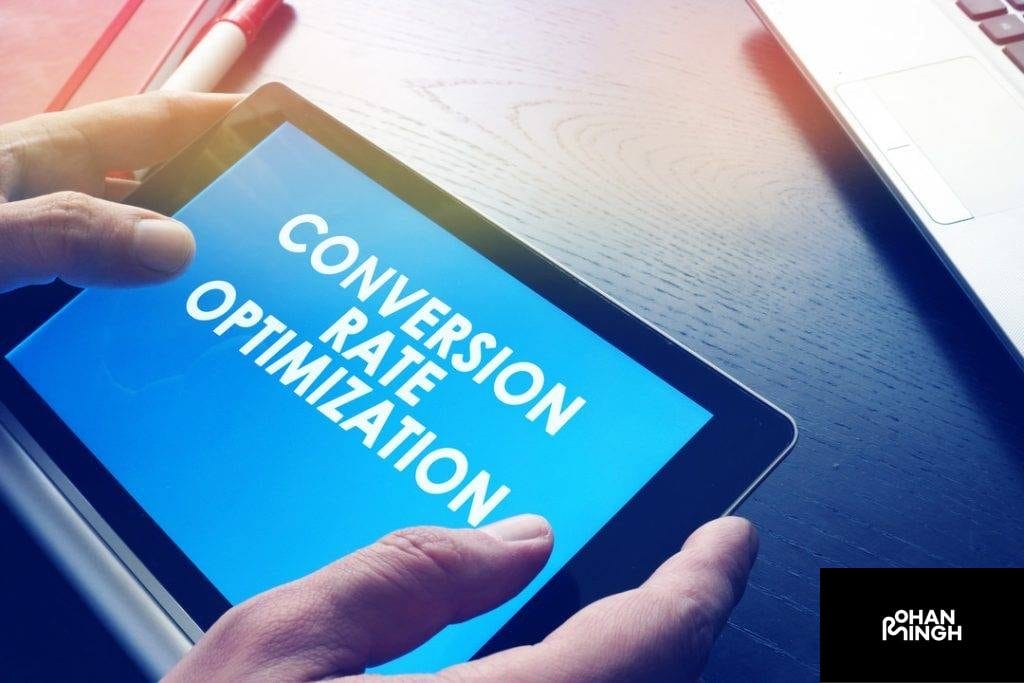Want to Transform Your Manufacturing Site’s Conversions on Mobile with AI?

What Is Mobile Conversion Rate Optimization?
Mobile Conversion Rate Optimization (CRO) is the process of improving the effectiveness of a manufacturer’s website to convert mobile visitors into customers. With the increasing use of mobile devices, it is essential for businesses in the manufacturing industry to optimize their websites for mobile users. Mobile conversion rate optimization involves making strategic changes to enhance the mobile experience, streamline the buying process, and maximize sales conversions. By focusing on factors such as mobile site speed, user engagement, user experience, and relevant content, manufacturers can significantly increase their mobile conversion rates. Implementing mobile-friendly designs, optimizing loading time, and simplifying the checkout process are crucial steps in boosting website conversion for manufacturing businesses. Utilizing tools and applications that analyze user behavior and track mobile traffic can provide valuable insights to inform marketing strategies and campaigns. By adopting a mobile-first approach and continuously monitoring and refining the mobile conversion strategy, manufacturers can effectively draw in potential customers and increase their mobile conversion rates.
Table of Contents
ToggleWhy Is Mobile Conversion Rate Optimization Important for Manufacturing Websites?
In today’s digital age, having a strong online presence is crucial for every industry, including manufacturing. As more potential customers use mobile devices for their online activities, optimizing your manufacturing website for mobile conversion has become imperative. Mobile Conversion Rate Optimization (CRO) focuses on enhancing the user experience and increasing conversion rates specifically for mobile users. This strategy differs from traditional desktop CRO and requires a unique approach to cater to the needs and behaviors of mobile users.
1. Mobile Users are Becoming the Majority:
With the increasing use of smartphones and tablets, a significant percentage of internet traffic now comes from mobile devices. Manufacturers need to adapt their websites to capture the attention of this growing mobile audience. Ignoring mobile optimization can lead to missed opportunities and potential customers going to competitors who provide a seamless mobile experience.
2. Enhanced Conversion Rates:
Studies have shown that mobile-friendly websites tend to have higher conversion rates compared to their non-optimized counterparts. Optimizing the website for mobile devices improves load time, user engagement, and overall user experience. This, in turn, increases the likelihood of turning mobile visitors into customers, boosting sales conversions.
3. Seamless Experience for All Users:
It is important to note that a successful mobile CRO strategy doesn’t only cater to mobile users but also provides a seamless experience for desktop users. As users may switch between devices during their buying decision process, maintaining consistency across different screens sizes and load times creates a cohesive and positive brand experience.
Manufacturing websites need to prioritize mobile conversion rate optimization to stay competitive in the digital era. By focusing on user behavior, loading speed, and presenting relevant content, manufacturers can effectively convert potential customers into actual buyers. Embracing mobile CRO ensures that your manufacturing website is accessible, engaging, and persuasive across all platforms, taking your business to new heights.
Let's talk about your future project!
Eager to collaborate on your upcoming endeavor? Let's explore and ignite the potential of your next big idea, shaping a promising future together!
Understanding Your Audience
Understanding your audience is a key factor in boosting website conversion in manufacturing through mobile optimization. By gaining insights into your target audience’s preferences, behaviors, and needs, you can tailor your mobile CRO strategy to effectively engage and convert potential customers. Gathering data and understanding user behavior is essential in creating a seamless and personalized experience across all devices. By using tools and applications, businesses can analyze user demographics, device usage, and browsing patterns to optimize their mobile websites and ensure they are catering to the specific needs of their audience. This understanding allows manufacturers to create relevant content, optimize loading times, and implement conversion strategies that resonates with their potential customers, ultimately increasing the chances of converting mobile visitors into loyal customers.

Analyzing Your Target Audience
Understanding your target audience is crucial for boosting website conversion in manufacturing, especially when optimizing for mobile devices. By analyzing their needs and preferences, you can create a mobile experience that resonates with potential customers and drives conversions. Here are some methods to gather feedback and gain insights into your target audience:
1. Request Reviews and Testimonials: Encourage mobile users to leave reviews and testimonials about their experience with your website. Positive reviews act as social proof, which can influence potential customers to make a buying decision.
2. Track User Behavior through Analytics: Utilize analytics tools to analyze user behavior on mobile devices. This data includes metrics such as mobile conversions, load time, screen size, and engagement. By understanding how mobile visitors interact with your site, you can identify areas to improve and optimize for better conversion rates.
3. Participate in Industry Forums: Engage with your target audience on industry forums and discussion platforms. This allows you to listen to their concerns, answer their questions, and gain valuable insights into their pain points and motivations. Use this information to tailor your marketing campaigns and strategies for mobile users.
4. Conduct Regular Customer Surveys: Create surveys to gather feedback directly from your existing customers. Ask about their experience with your mobile site, mobile checkouts, loading speed, payment methods, and overall satisfaction. This will provide you with valuable insights into their preferences and help you optimize your mobile experience accordingly.
By analyzing your target audience through these methods, you can gain a deeper understanding of their needs, preferences, and behaviors. This knowledge will enable you to optimize your mobile manufacturing conversion strategy and effectively convert mobile visitors into customers. Remember to continuously monitor and adapt your approach based on the feedback and data you gather.
Identifying Potential Customers
As an AI Marketing Expert, I understand the significance of identifying potential customers. It all starts with understanding your target audience’s needs and preferences. By gaining insights into their motivations and pain points, you can create a mobile experience that resonates with them and drives conversions in the manufacturing industry.
One effective method is conducting surveys and interviews. By directly interacting with your target audience, you can gather valuable feedback about their mobile manufacturing conversion experience. Ask specific questions about their preferences, mobile usage habits, and any challenges they face during the conversion process. Tools like SurveyMonkey or Google Forms can assist in collecting and analyzing survey data.
Analyzing customer service data is another useful approach. Explore customer support interactions to identify common concerns or complaints related to mobile manufacturing conversion. Tools like Zendesk or Freshdesk can help track and analyze customer service data, allowing you to gather insights into potential pain points and areas for improvement.
By combining survey data, interviews, and customer service data analysis, you can gain a comprehensive understanding of your target audience. With these insights, you can optimize your mobile manufacturing conversion strategy to better meet their needs and preferences, thus boosting website conversion rates.
Assessing User Experience Needs
In the era of mobile devices, assessing user experience needs on manufacturing websites is crucial for success. With an increasing number of potential customers accessing websites through their mobile devices, it is essential to optimize user experience for this target audience.
A well-optimized mobile website provides a faster and more seamless experience for users. According to statistics, mobile users have shorter attention spans and higher expectations for load time compared to desktop users. In fact, 53% of mobile users abandon a website if it takes more than three seconds to load. By optimizing for mobile devices, manufacturers can ensure a positive and efficient experience for their target audience.
Mobile optimization also has a significant impact on user engagement and conversion rates. Studies show that mobile conversion rates are lower than desktop conversion rates, with slow-loading websites and poor mobile experience being the primary reasons. By prioritizing mobile optimization, manufacturing websites can drive higher user engagement and conversion rates, ultimately turning more mobile visitors into customers.
To assess user experience needs, manufacturers can utilize various tools and applications. Tools like Google Analytics, which provide insights into mobile traffic and user behavior, can help identify areas of improvement. Additionally, usability testing platforms like Optimizely or UserTesting can provide valuable feedback on mobile website performance and highlight areas that need optimization.
By understanding user experience needs on mobile devices and implementing effective mobile optimization strategies, manufacturers can stay ahead of the game and drive better conversion rates on their websites.

Optimizing Your Mobile Website
In today’s digital landscape, optimizing your mobile website is essential for boosting website conversion in manufacturing. With the increasing number of mobile users and potential customers, it is crucial for manufacturers to cater to the needs and preferences of their mobile audience. According to research, mobile users have higher expectations for load time and a shorter attention span compared to desktop users. In fact, more than half of mobile users abandon a website if it takes more than three seconds to load. By prioritizing mobile optimization, manufacturers can ensure a faster and more seamless experience for their target audience, leading to higher conversion rates.
To optimize your mobile website for manufacturing conversion, it is important to focus on two key areas: user experience and load time. Slow-loading websites and poor mobile experience are the primary reasons behind lower mobile conversion rates. By utilizing tools and applications like Google Analytics and usability testing platforms, manufacturers can gather insights into mobile traffic, user behavior, and identify areas of improvement. This data-driven approach enables manufacturers to make informed decisions when it comes to optimizing their mobile websites, ultimately transforming more mobile visitors into customers.
Furthermore, by implementing strategies such as a guest checkout option, mobile-friendly forms with fewer form fields, and integrating popular payment methods like Android Pay, manufacturers can streamline the mobile checkout process and remove any barriers that may hinder the buying decision of potential customers. Additionally, incorporating social proof and personalized product recommendations can boost user engagement and increase the likelihood of sales conversions on mobile devices. By creating relevant content and CTAs, optimizing loading speed, and ensuring a smooth mobile experience, manufacturers can harness the power of mobile conversion optimization and drive success in their digital marketing campaigns.
Ensuring Fast Load Times
Ensuring fast load times on your mobile website is crucial for boosting mobile manufacturing conversion rates. Studies show that page load time impacts user engagement and ultimately affects conversion rates on mobile devices. Here are key strategies to optimize your website’s speed and enhance mobile user experience:
1. Image optimization: Eliminate large images that slow down your mobile site. Compress and resize images without compromising quality. Utilize modern formats like WebP to reduce file sizes while maintaining visual appeal.
2. Accelerated Mobile Pages (AMPs): Leverage AMP technology to create fast-loading mobile web pages. AMPs prioritize content and streamline code, resulting in quicker load times on mobile devices.
3. Minimize HTTP requests: Each element on your webpage requires an HTTP request, consuming load time. Reduce the number of requests by combining CSS and JavaScript files, utilizing CSS sprites, and minimizing unnecessary script usage.
4. Implement caching: Utilize browser caching by setting appropriate cache-control headers. This allows mobile devices to store certain webpage elements locally, reducing subsequent load times.
5. Utilize online tools: Take advantage of tools like Google PageSpeed Insights and GTmetrix to identify areas where improvement is needed. These tools provide insights into page load times, optimization suggestions, and performance metrics.
By implementing these strategies, you can reduce your mobile website’s page load time to a recommended maximum of four seconds, thus improving user experience and driving higher mobile manufacturing conversion rates.
Improving Checkout Processes
Improving the checkout process for mobile devices is crucial for boosting mobile conversions in the manufacturing industry. A long and difficult checkout process can lead to potential customers abandoning their purchase. To optimize the checkout process, focus on the following areas.
Firstly, cut down on unnecessary steps by minimizing the number of form fields. Mobile users prefer a streamlined experience, so only ask for essential information. Studies show that reducing form fields can significantly improve conversion rates.
Next, enhance the user experience by providing a progress indicator. This allows customers to see how far they are in the checkout process and provides a sense of control and convenience.
Offering guest checkout is another effective strategy. Many mobile users want a quick and hassle-free experience, and the requirement to create an account can deter them from completing their purchase. Guest checkout allows users to skip account creation and proceed directly to payment.
Lastly, provide simple payment methods. Offering options such as mobile wallets (e.g., Apple Pay, Android Pay) can significantly improve the checkout experience. Users appreciate the convenience and speed of these payment methods, leading to higher conversion rates.
By focusing on a simple, clean, and frictionless checkout experience, manufacturers can boost mobile conversion rates and turn potential customers into satisfied buyers. Don’t overlook the power of the checkout process in driving mobile conversions.

Developing Responsive Designs for All Screen Sizes
Developing responsive designs for all screen sizes is crucial for mobile manufacturing conversions. With the growing number of mobile users and potential customers, it is important to ensure that your website looks great and functions effectively on any device.
One strategy to achieve this is by using responsive design techniques such as fluid grids, flexible images, and media queries. Fluid grids allow your website to adapt and resize automatically based on the user’s screen size, providing a consistent and visually appealing layout. Flexible images ensure that images adjust and scale proportionally to fit different screen sizes, avoiding any distortion or loss of quality. Media queries enable you to define specific styles and layouts for different screen sizes, ensuring an optimal user experience for each device.
For example, a mobile-friendly website with a responsive design may have a navigation menu that transforms into a collapsible menu icon on smaller screens. This allows users to access the menu easily without it occupying too much screen space.
Adopting a mobile-first approach is also crucial. This involves prioritizing the design and functionality of your website for mobile users initially, then expanding and optimizing for larger screens. Conducting thorough testing on various devices can help identify any design issues or inconsistencies and allow for appropriate adjustments to be made.
Tools and applications such as Google’s Mobile-Friendly Test and Responsive Design Checker can assist in evaluating and optimizing your website’s responsiveness for different screen sizes. Ensuring that your website is optimized for all screen sizes will enhance user engagement, improve the mobile experience, and ultimately boost mobile manufacturing conversions.
Adding Features Such as Android Pay, Guest Checkout and Product Recommendations
Incorporating features such as Android Pay, Guest Checkout, and On-Page Product Recommendations into your manufacturing website’s mobile conversion optimization strategy can significantly boost your conversion rates and enhance user experience.
Firstly, by integrating Android Pay, you provide your potential customers with the convenience of secure mobile payments. This feature allows mobile users to complete transactions quickly and easily, reducing friction in the buying decision process and increasing the likelihood of a successful conversion.
Secondly, offering a guest checkout option can streamline the checkout process for mobile users. Many potential customers prefer a simplified checkout experience without the need to create an account. By enabling guest checkout, you eliminate unnecessary steps and form fields, making it easier for mobile visitors to convert into customers.
Lastly, incorporating on-page product recommendations can enhance user engagement and encourage additional purchases. By showcasing relevant products based on user behavior and preferences, you offer a personalized and tailored experience to mobile visitors. This feature not only increases the average order value but also improves user satisfaction and the likelihood of future conversions.
By incorporating Android Pay, guest checkout, and on-page product recommendations into your mobile conversion optimization strategy, you can simplify the checkout process, improve user experience, and ultimately increase your conversion rates. Make sure to leverage tools and applications such as mobile payment gateways, guest checkout plugins, and AI-powered recommendation engines to maximize the impact of these features on your mobile manufacturing conversion.
Improving Mobile Visitor Engagement
In today’s digital landscape, it is crucial for manufacturing businesses to optimize their websites for mobile devices in order to boost website conversion rates. With the increasing number of mobile users and the significant role they play in the buying process, capturing and engaging mobile visitors has become a top priority. To improve mobile visitor engagement and ultimately increase conversions, there are several strategies that can be implemented. By ensuring a seamless and user-friendly mobile experience, businesses can capture the attention of potential customers, encourage longer visit durations, and ultimately drive more conversions. This can be achieved through techniques such as optimizing load time and mobile screen size, implementing a mobile-friendly layout, simplifying the checkout process, and providing relevant and compelling content. By focusing on improving the mobile visitor’s experience and addressing their unique needs and preferences, manufacturing businesses can significantly enhance their mobile conversion rates and turn their mobile visitors into valuable customers.

Enhancing Search Engine Optimization (SEO) Strategies
In the ever-evolving world of digital marketing, optimizing your website for mobile devices has become increasingly important. With the growing number of mobile users and potential customers accessing websites through their smartphones and tablets, it is imperative for businesses, especially those in the manufacturing industry, to prioritize mobile optimization in order to boost website conversion rates.
One of the key reasons for enhancing search engine optimization (SEO) strategies for mobile optimization is the impact it has on search engine rankings. Search engines, such as Google, take into consideration the mobile-friendliness of a website when determining its rankings. Therefore, by ensuring that your website is mobile-friendly and optimized for mobile search, you can improve your online visibility and increase the chances of your products being found by your target audience.
To optimize your mobile site for search engines, there are several strategies that you can employ. Firstly, using keyword-rich meta descriptions can help search engines understand the relevance of your website to user queries. Secondly, embedding target keywords in titles and headings can further enhance your website’s visibility in search results. Additionally, utilizing Google’s mobile testing tools, such as Google’s Mobile-Friendly Test and PageSpeed Insights, can provide valuable insights into the performance of your mobile site, helping you identify areas for improvement and fine-tune your mobile optimization strategy.
Enhancing search engine optimization (SEO) strategies for mobile optimization is crucial for manufacturing businesses looking to convert mobile visitors into customers. By focusing on mobile-friendly design and implementing effective SEO techniques, such as keyword optimization, businesses can improve their search engine rankings, increase online visibility, and ultimately drive more traffic and conversions.
Creating Relevant Content for Mobile Visitors
In the world of mobile manufacturing conversion, creating relevant content for mobile visitors is key to success. As more and more users access websites through their smartphones and tablets, it is crucial to optimize your content for mobile devices.
One of the primary reasons to create relevant content for mobile visitors is to enhance user experience. Mobile users have different needs and preferences compared to desktop users. By tailoring your content to the mobile screen size and loading speed, you can provide a seamless browsing experience. This improves user satisfaction, encourages longer engagement, and reduces bounce rates, ultimately boosting conversions.
Creating relevant content also plays a role in increasing search engine rankings. Search engines consider mobile-friendliness as a ranking factor. By optimizing your content for mobile devices, you can improve your website’s visibility in search results. This means that when potential customers search for products or services related to mobile manufacturing, your website has a higher chance of being found.
To create compelling content for mobile visitors, it’s important to keep it concise and engaging. Mobile users have limited attention spans and are often on the go. Utilize clear headings, bullet points, and short paragraphs to make the content easy to read and digest. Additionally, include mobile-focused visuals such as infographics or videos to enhance the user experience and increase engagement.
Furthermore, incorporating mobile apps and features can provide additional benefits. Features like click-to-call or location-based services enable users to easily contact your business or find your physical store. This convenience can significantly increase conversion rates and drive more sales.
Creating relevant content for mobile visitors is essential for improving user experience, increasing search engine rankings, and ultimately boosting conversions in the mobile manufacturing industry. By tailoring your content to mobile devices and utilizing mobile apps and features, you can effectively engage your audience and turn mobile visitors into valuable customers.
Utilizing Push Notifications to Improve User Engagement
Utilizing push notifications is a powerful strategy to improve user engagement on a mobile website, especially when leveraging the information obtained from mobile user monitoring. Push notifications are messages that are sent directly to a user’s mobile device, providing real-time updates and valuable information. Here’s how you can make the most of push notifications to boost user engagement and ultimately increase conversions on your mobile website.
One of the key benefits of push notifications is their ability to captivate users with well-timed popups and triggered emails. You can take advantage of this by promoting discounts, offers, or limited-time deals through push notifications. By delivering these messages at the right moment, such as when a user is browsing a specific product category, you can increase the chances of conversion.
To engage passive visitors, consider using triggers such as exit-intent and inactivity triggers. When a user is about to leave your mobile website, an exit-intent trigger can be triggered to display a push notification with a special offer or incentive to encourage them to stay or make a purchase. Additionally, inactivity triggers can be set to send a push notification to users who haven’t interacted with your mobile website for a certain period. These notifications can serve as reminders, personalized recommendations, or exclusive content, incentivizing users to re-engage and take action.
To implement push notifications effectively, you can utilize tools or applications such as OneSignal, Pusher, or Firebase Cloud Messaging. These platforms offer easy integration with mobile websites and provide features to segment your audience, personalize messages, and track the performance of your push notifications.
By leveraging the power of push notifications, you can improve user engagement on a mobile website, deliver timely offers, and ultimately boost conversions.

Conclusion
In conclusion, mobile conversion rate optimization plays a crucial role in driving success for manufacturing websites. By optimizing for mobile devices, businesses can unlock the potential of reaching a larger audience of mobile users and turning them into potential customers. The increased usage of mobile devices highlights the need for manufacturing websites to prioritize the mobile experience.
Implementing strategies such as utilizing push notifications, exit-intent triggers, and inactivity triggers can significantly improve the user experience and drive higher conversion rates. These tactics allow businesses to capture the attention of mobile visitors at the right moment, offering them personalized recommendations, exclusive deals, and reminders. By engaging passive visitors and providing relevant content, businesses can effectively nurture the user journey and increase the likelihood of turning visitors into customers.
To implement these strategies, businesses can leverage tools and applications such as OneSignal, Pusher, or Firebase Cloud Messaging. These platforms offer seamless integration with mobile websites and provide features to segment audiences, personalize messages, and track the performance of push notifications.
By focusing on mobile conversion rate optimization, manufacturing websites can enhance user experience, increase conversion rates, and ultimately drive more sales. It is a valuable investment for businesses looking to stay competitive in today’s digital landscape.
FAQs
What is website conversion?
Website conversion refers to the percentage of website visitors who take a desired action, such as making a purchase, filling out a form, or subscribing to a newsletter. It measures how effectively a website is able to turn visitors into customers or leads.
What is the average conversion rate in the eCommerce industry?
The average conversion rate in the eCommerce industry varies depending on various factors such as the industry, target audience, and marketing strategies. However, studies suggest that the average conversion rate is around 2-3%. However, it’s important to note that conversion rates can significantly vary within industries and across different types of mobile devices.
What factors affect website conversion rates?
Several factors can impact website conversion rates, including website design, user experience, loading speed, mobile optimization, relevant content, trust factors such as social proof, and the ease of the checkout process. These elements play a crucial role in influencing the buying decision of potential customers.
Why is mobile optimization important for website conversion rates?
Mobile devices are increasingly becoming the primary source of internet traffic, with a significant portion of potential customers accessing websites through their smartphones or tablets. Optimizing for mobile devices is crucial to provide a seamless user experience, improve loading speed, and offer mobile-friendly features such as easy navigation, guest checkout, and multiple payment methods. Ignoring mobile optimization can lead to a high bounce rate and missed opportunities to convert mobile visitors into customers.
What Marketing Strategy Did Cheetos Employ for Plants vs. Zombies Collaboration?
Rohan Singh | May 1, 2024 | Acquisition What Marketing Strategy Did Cheetos Employ for Plants vs. Zombies Collaboration? Background on Cheetos Cheetos, a popular brand of cheese-flavored snacks, has made a name for itself with its bold and playful marketing strategies. Known for its irreverent and creative campaigns, Cheetos has consistently found unique ways […]
What Marketing Strategy Did Cheetos Employ for Plants vs. Zombies Collaboration?
Rohan Singh | May 1, 2024 | Acquisition What Marketing Strategy Did Cheetos Employ for Plants vs. Zombies Collaboration? Background on Cheetos Cheetos, a popular brand of cheese-flavored snacks, has made a name for itself with its bold and playful marketing strategies. Known for its irreverent and creative campaigns, Cheetos has consistently found unique ways […]
What Differentiates Differentiated Marketing Strategy from Undifferentiated?
Rohan Singh | April 30, 2024 | Acquisition What Differentiates Differentiated Marketing Strategy from Undifferentiated? Definition of Differentiated Marketing Strategy A differentiated marketing strategy is a targeted approach that focuses on creating unique products or services to meet the specific needs and preferences of different customer segments. It recognizes that customers have diverse tastes, preferences, […]
What Sets Apart the Marketing Concept from a Marketing Strategy?
Rohan Singh | April 29, 2024 | Acquisition What Sets Apart the Marketing Concept from a Marketing Strategy? Definition of Marketing Concept The marketing concept is a philosophy that places the customer at the center of all marketing activities. It focuses on understanding the needs and wants of the target market and delivering value to […]
Which promotional mix strategy targets market channel members?
Rohan Singh | April 28, 2024 | Acquisition Which promotional mix strategy targets market channel members? When it comes to promoting a product or service, companies utilize various strategies to reach their target audiences. One key strategy that directs marketing efforts toward market channel members is known as trade promotion. Trade promotion is a type […]
Should charter schools adopt regional or national marketing strategies?
Rohan Singh | April 27, 2024 | Acquisition Should charter schools adopt regional or national marketing strategies? Purpose When it comes to marketing strategy in the field of charter schools, two broad approaches can be taken: regional and national. Each approach has its purpose and benefits depending on the goals and aspirations of the charter […]
How Can ChatGPT Empower Your Laravel Factory Creation?, Ready to Optimize? How Can You Truly Master Google Bard?, How Can You Integrate Your Own Data with ChatGPT?, How to Create an Effective Digital Signage Marketing Strategy?, What Makes an Effective Beer Branding Strategy?, How to Develop an Effective Ecommerce CRM Strategy?, How to Optimize Your University’s Social Media Strategy?, Zappos Social Media Strategy: Leveraging Digital Platforms for Success, Unveiling Blue Apron’s Dynamic Marketing Strategy: Enhancing Culinary Experience through Innovative Campaigns, What distinguishes a digital strategy from digital marketing?, What is the Role of Predictive Analytics in Marketing Strategy, Specifically for Facebook?, How Do Harry Potter and Voldemort Differ in Marketing Strategies?, What Differentiates a Go-to-Market Strategy from a Marketing Plan?, How Do Marketing Tactics and Strategy Differ in Playboy’s Approach?
What’s the Relationship Between Marketing and Design Strategy?, How Does Digital Marketing Strategy Differ from Traditional Marketing Strategy?, How Does Brand Strategy Align with Integrated Marketing?, What differentiates a marketing campaign from a marketing strategy?, What is the difference between marketing strategy and marketing mix?, What is the difference between marketing strategy and business strategy?, What are the key differences in marketing strategies for profit and nonprofit organizations?, What Is the Difference Between Marketing Strategy and Growth Strategy?, What’s the Difference Between Marketing Strategy Position and Execution?, How Does Consumer Behavior Influence Marketing Strategy?, What sets apart a marketing strategy from strategic marketing?, What Sets Apart Communications Strategy from Marketing Strategy?, What Are Some Examples of Content Strategy vs Content Marketing?, How does the battle between good and evil influence marketing strategies?, How Did Cheetos Utilize a Marketing Strategy with Plants vs. Zombies?
Topics :
Share :






